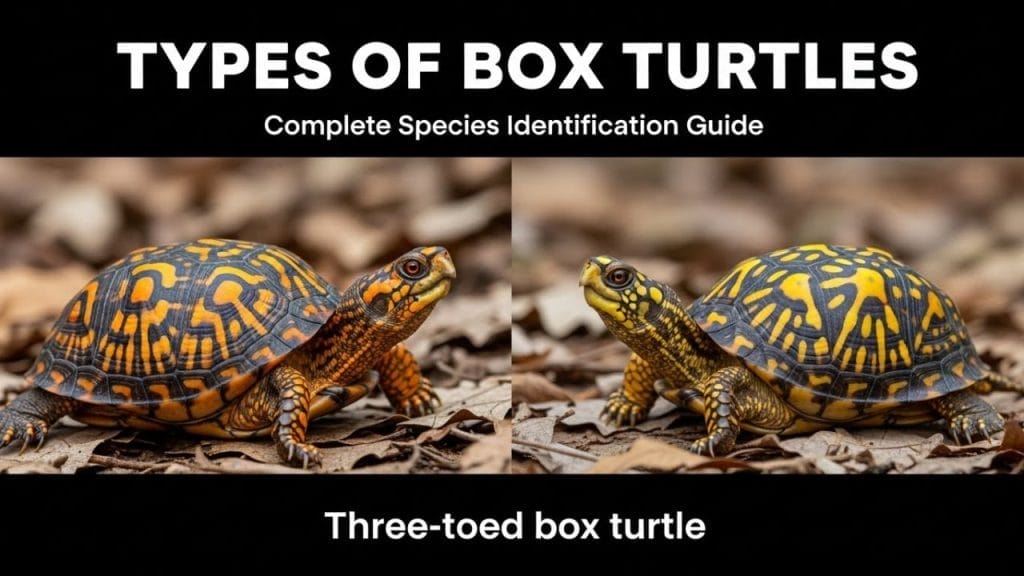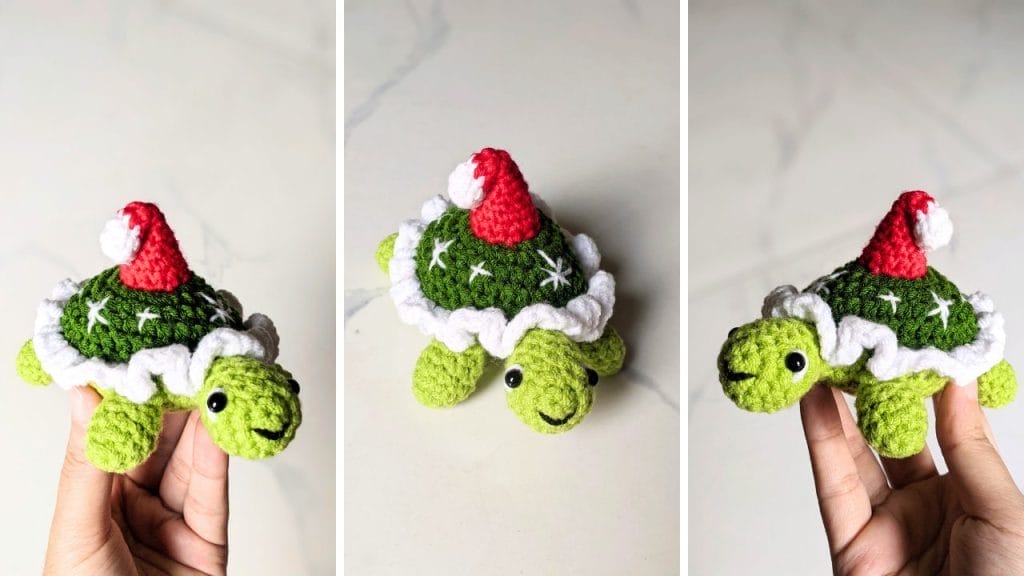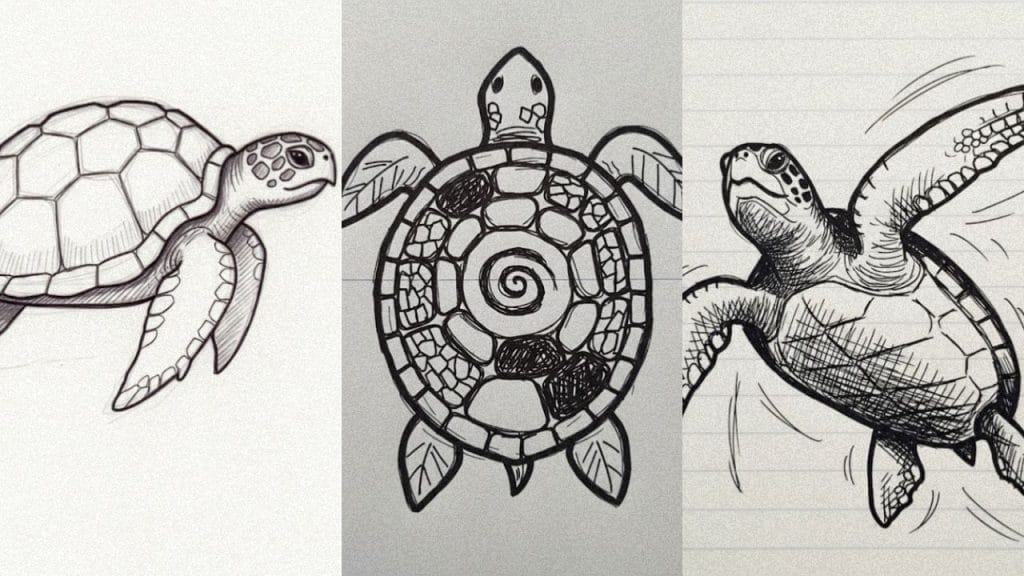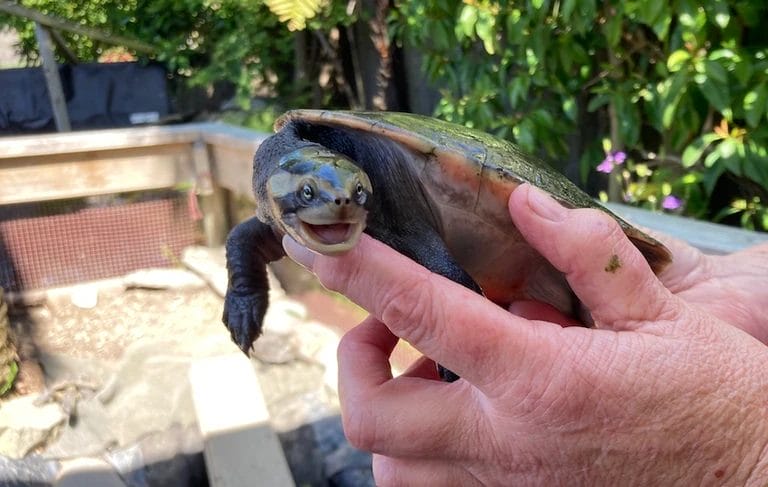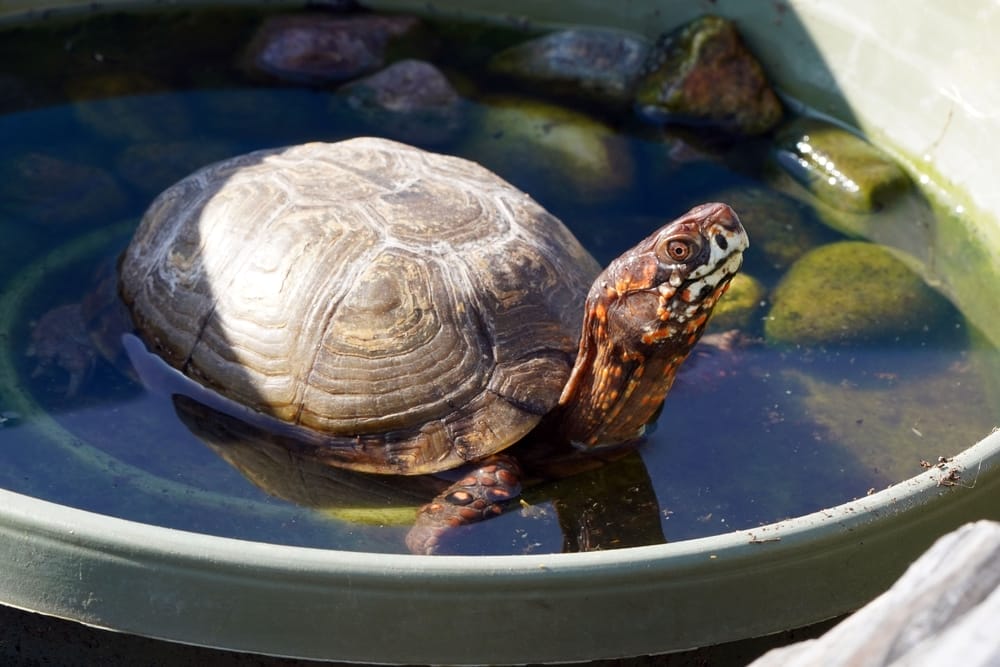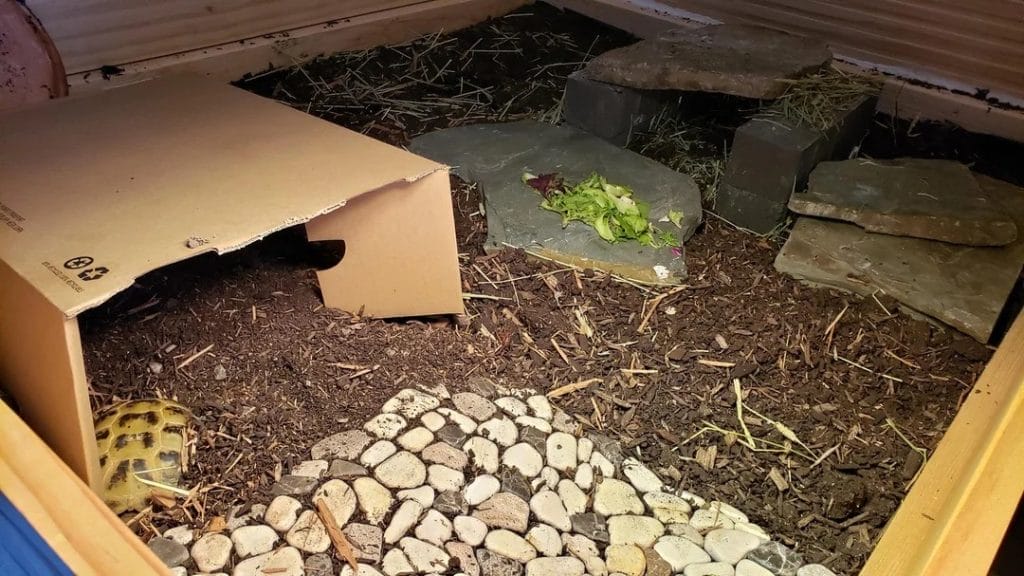What Happens If A Tortoise Gets Too Cold?

This post was created with help from AI tools and carefully reviewed by a human (Muntaseer Rahman). For more on how we use AI on this site, check out our Editorial Policy.
Winters are always a difficult time for the tortoises. They switch to hibernation mode to survive the cold. What happens if the winter gets more chilly than ever? Will hibernation save the tortoises from this harsh weather?
Tortoises can hibernate healthily at a temperature of 45 – 55F. In fact, a temperature range of 37 – 44F is also stable for them. However, if the temperature falls below 37F by any chance, the tortoises will freeze to death. So, moving the pets to a warmer spot is suggested in harsh winters.
How can you handle the too-cold weather for tortoises? Find out below!
5 Effects Of Cold Temperature On Tortoises
Tortoises are cold-blooded creatures. They require an external heating source to keep their bodies warm. When the temperature drops, the tortoises will change their lifestyles to cope with the cold.
If the temperature reaches a sub-zero point, it can make the tortoises suffer miserably. Well, cold temperature affects these creatures in many ways. Some common scenarios are as follows,
1. Always Dozing
Tortoises are naturally fans of high temperatures. For example, their daytime enclosure temperature is consistently over 70F.
However, the pets prefer 65 – 70F pen temperature during the night. A chilly temperature at night helps the tortoises relax and sleep peacefully.
What if you maintain this low temperature during the daytime too? In such cases, you will find your tortoises always napping and dozing in the corner.

2. Inactivity
As the temperature drops below 65 – 70F, your tortoises become inactive and lethargic. It is because this species is ectothermic and solely depends on external heating sources to operate their bodies.
Therefore, tortoises shift to their stored energies when the temperature falls to carry out crucial biological functions. They refuse to waste any of their energies on dumb activities.
3. Loss Of Appetite
Cold weather slows the metabolism of tortoises. Hence, these creatures need more time to digest one meal and produce energy. As a result, tortoises tend to stop eating when the temperature falls.
4. Vulnerable To Diseases
A cold temperature is never a blessing for tortoises. The pets switch to inactive mode and show little interest in meals. Because of insufficient food and minerals, their immunity system takes a toll. Thus, tortoises become exposed to more cold and infectious diseases.
5. Hibernation
Longer naps, lethargy, appetite loss, etc., are expected when the temperature drops by 5 – 10. What if the temperature falls below 50 – 55F? Tortoises completely shut down their systems in such cases and enter hibernation mode.
Brumation or hibernation is a natural process. During this period, tortoises slow their metabolism, heart rate, and oxygen consumption percentage. So, you will find the reptiles burrowing in the substrate or dry leave dump.
Hibernation is a deep sleep state for the tortoises. They do not eat and barely drink during this process.
What If It Is Too Cold For The Tortoises?
As mentioned, tortoises are not cheerful about the winter. Instead, they enter a different physical zone, aka energy saving mode, to survive the cold. These reptiles will hibernate for up to 3 months to survive the chilly weather.
The ideal hibernation temperature for tortoises is 45 – 55F. In fact, 37 – 44F is also suitable for hibernating pets, depending on the regional weather.
What happens if the temperature falls below 40F? Will the tortoises survive the chill?
Unfortunately, tortoises cannot withstand such lower temperatures(below 37F). Therefore, the creatures will freeze to death.
This Hilarious Turtle Book Might Know Your Pet Better Than You Do
Let’s be real—most turtle care guides feel like reading a textbook written by a sleep-deprived zookeeper.
This one’s not that.
Told from the snarky point of view of a grumpy, judgmental turtle, 21 Turtle Truths You’ll Never Read in a Care Guide is packed with sarcasm, sass, and surprisingly useful insights.
And hey—you don’t have to commit to the whole thing just yet.
Grab 2 free truths from the ebook and get a taste of what your turtle really thinks about your setup, your food choices, and that weird plastic palm tree.
It’s funny, it’s honest, and if you’ve ever owned a turtle who glares at you like you’re the problem—you’ll feel seen.
How Cold Is Too Cold For The Tortoises?
The ideal daytime temperatures for warmer and cooler zones in the tortoise enclosure are 75 – 90F and 65 – 75F, respectively. Likewise, the basking temperature for this species can be 90 – 105F. In these temperature ranges, your tortoises will be most playful and active.
During the nighttime, tortoises prefer chilly surroundings. Hence, a 60 – 70F temperature is suggested in the pen for their bedtime.
Well, you have nothing to worry about if the temperature drops to 50 – 55F by mistake. You will notice that pets have a changed lifestyle. For example, appetite loss, fatigue, longer naps, etc.
Of course, you can not allow a low habitat temperature for long. It will make the tortoises sick. Therefore, you must regulate the temperatures back to the suitable ranges.
If it is winter and you plan to put the tortoises in hibernation, strategically drop the temperature to 40 – 50F. In no conditions, the temperature should fall below 37F. Such a low temperature is dangerous for the tortoises. They will be ice cold and die miserably.
However, the cold tolerance of wild tortoises is always better. According to records, wild tortoises can sustain 30F and lower.
Furthermore, the ability to withstand cold varies from tortoise to tortoise. For instance, a healthy adult tortoise can survive harsh winters. Likewise, babies and old pets are most vulnerable to the cold.

Perfect Wooden Tortoise House For Outdoor & Indoor!
This tortoise house isn’t cheap — but that’s because it’s not your average wooden box.
Built with durable wood, a waterproof liner, and smart design features like a sunbathing area and a hideout zone, the Aivituvin Large Wooden Habitat is made to last.
It’s perfect for tortoises or box turtles, indoors or out. And yep, it even has detachable legs.
If you’re serious about giving your tortoise a safe, comfy home without building one from scratch, this is the one.
👉 Grab the Aivituvin Tortoise House here — it’s currently $10 off.
How To Handle Too-Cold Temperature For Hibernating Tortoises?
In the wild, tortoises can sense the winter beforehand. Therefore, the creatures take physical and mental preparation accordingly.
These tortoises do not have to worry about the harsh temperature drop. Because of their survival instincts and resilience, they can handle freezing temperatures during hibernation.
But when in captivity, the owners create artificial surroundings. As a result, the pets are entirely dependent on the keepers. So, if you plan to hibernate your tortoises, you are responsible for maintaining a suitable temperature range.
There are 3 popular hibernating methods for tortoises. Allow me to explain how to handle their temperatures so that the pets do not freeze to death.
1. The Fridge Method
As per this technique, you put the tortoise in a box first and then place the container in a refrigerator. It is a safe and effective method because you get to regulate the freezing temperature. More details on this method are as follows,
- Take a box (wood, paper, or plastic) larger than the tortoise.
- Drill some holes in the container for air passage.
- Lay the box floor with a suitable substrate (sterilized dirt, aspen shavings, etc.) for the tortoises.
- Cross-check the temperature settings of the refrigerator. We need a stable temperature between 37 – 44F. Temperatures below 37F and above 50F are not expected.
- The fridge must be in a temperature-controlled room. Keeping the refrigerator in a cold room can lower the inside temperature.
- Place 2 water bowls to maintain humid surroundings inside the refrigerator.
- Now the tortoise is all set for hibernation inside the fridge.
- You have to keep the refrigerator door open for a few minutes thrice or four times a week for ventilation purposes.
2. The Box Method
This technique does not give you complete control of the temperature. Here you first adjust a small box in a large container and fill the gap between the walls with a substrate. It offers proper insulation for the hibernating tortoise.
Then, put the tortoise inside the small box and place it in the cold room of your house. It can be your basement, shed, or garage. In any case, the zone temperature must not fall below 37 – 44F.
The box method is unfit for your tortoises if the room temperature falls drastically without warning. In such scenarios, you can install a thermostat to regulate the temperature. Or switch to the box method for more control.
3. The Natural Method
Though this technique suits wild tortoises, it is not suitable for captive ones. There are risks of unpredicted weather, flood, and predators in outdoor hibernation. But if you still want to brumate your tortoise outside, prepare a burrowing spot with enough fencing and substrate.
How To Handle Too Cold Temperature For Non-Hibernating Tortoises?
What if it is freezing, and you do not want your tortoise to hibernate? What to do, then?
The easiest solution is to arrange proper heating arrangements for the tortoises. Enough heating sources will keep the pets warm and prevent hibernation.
Now, of course, it is easier to maintain a high temperature in an indoor home during the winter. Insulation pads, heating rocks, and heating pads will come in handy. You must install enough pads to cover the entire pen. Besides, a UV source is mandatory to fulfill the UVA and UVB requirements.
Well, an outdoor pen can serve the same purpose with a little adjustment. For example,
- Install heaters inside the dog house or the shed to accommodate the tortoises outdoors. 2 – 3 heaters will cover the area, depending on the habitat size.
- Move the dog house to a half-sunny and half-shady place. Direct sunlight is still crucial for pets.
- There must be open ground in front of the shed. The ground can trap heat and radiate a comfortable temperature of 60F. So, walking on the soil can warm off the tortoises.
- Moreover, the pen should be at least a foot above the ground to avoid unpredictable flooding. Build a ramp so that tortoises can get in and get down easily.
- Cover the pen with a sheet to save the pets from rainwater.
The heating pads and heaters allow you to regulate the temperature. Install a thermometer for more convenience.
Not all keepers prefer an open outdoor habitat for their tortoises. For them, a modified winter pen works better. Such housing lets you control the temperature more efficiently. Go to this link for a complete winter guide for tortoises.
Regardless of your arrangement type, maintain a healthy temperature inside the pen. Follow this temperature guide for tortoises if needed.

What Are The Best Tortoises For Cold Climate?
See, tortoises always prefer a high temperature. Colder weather is never their thing. Yet some tortoises have better resistance to cold than others. Hence, you should check out those species if you live in a colder region.
The best tortoises for cold weather are,
- Russian tortoise
- Marginated tortoise
- Hermann’s tortoise
- Greek tortoise
Well, sure, these tortoises can handle winter better than others. But still, they need additional heating sources and a warm enclosure. You must arrange a heated and insulated housing for these pets for a healthy winter.
Before You Go
Hibernation is the survival mechanism for tortoises. But it is associated with certain risks, which can push the pets towards permanent health damage and even death. The following article talks about the dangers of hibernation and the right method to hibernate your tortoises.
Is Your Tortoise Hibernating Or Dead?

About Author
Muntaseer Rahman started keeping pet turtles back in 2013. He also owns the largest Turtle & Tortoise Facebook community in Bangladesh. These days he is mostly active on Facebook.



